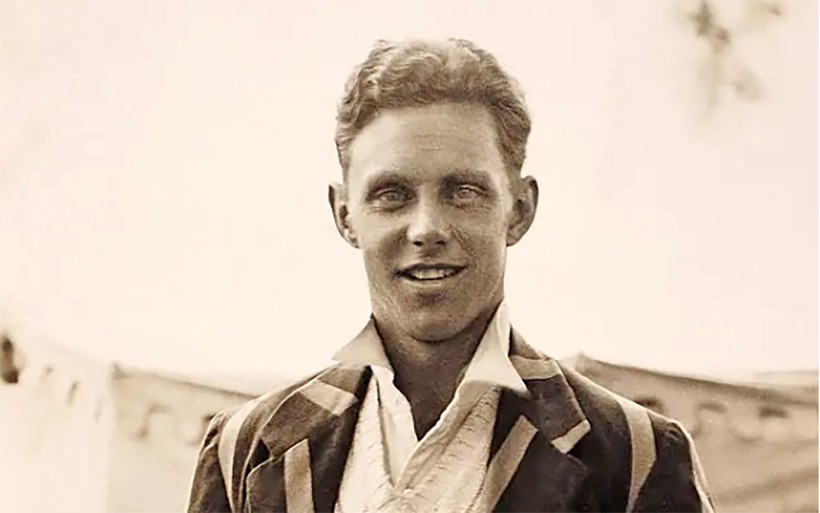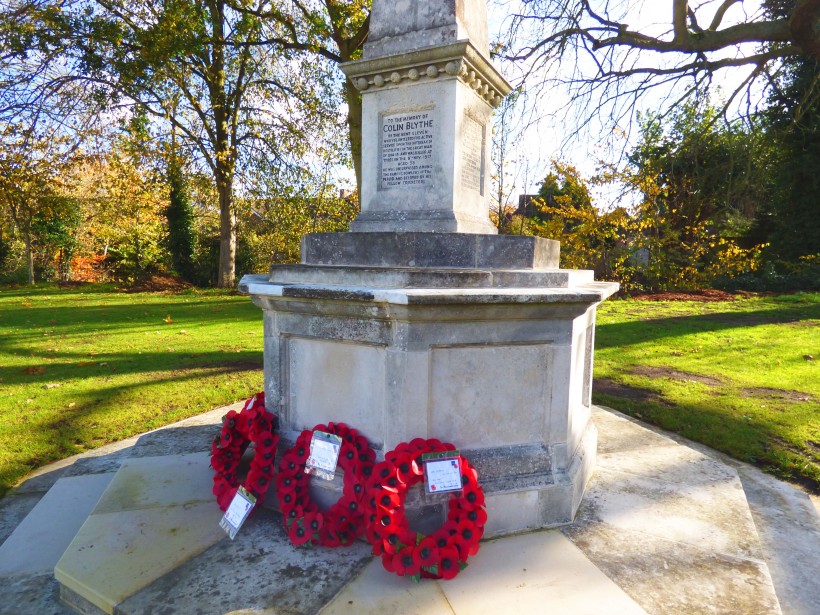Kent Remembers: Gerry Chalk
Tuesday 10th November 2020

Born; 7. 9.1910, Sydenham. Died: 17. 2.1943, Louches near Calais, France.
Kent 1933-1939. Kent cap (no.101), 1933.
County Captain: 1938-1939.
An inspirational captain and a batter excelling in the off-drive, cover-drive and square cut, Gerry Chalk was the son of a master butcher who, with a partner, owned Chalk & Cox, a chain of shops across South-East London and Metropolitan Kent.
When war broke out in 1939, Chalk was into his second year as Kent captain and approaching his peak as a player. He probably never played better than in Dover Week in the closing days of that last pre-war season, and was tragically shot down flying a Supermarine Spitfire over France in 1943.
Going up to Oxford in 1931, Chalk scored 26 and 20 in the Freshmens’ Match and 31 and 59 on his first-class debut, against Kent in the Parks. Although he hit only one other half-century, he did enough to hold his place and gain the first of his four cricket Blues.
In 1932 he did better, scoring almost 500 runs, opening the batting for most of the season and captaining
the side on occasions. In that July, he made his debut for Kent, against Surrey at Rectory Field, and retained his place for the remainder of the season, hitting three half-centuries with a top score of 78 v Nottinghamshire at Trent
Bridge. His record in all first-class matches was 1,055 runs (avge.28.51).
In 1934, his final year at Oxford, Chalk was appointed captain of his side and, with what Wisden described as his
‘lively, happy personality’, proved an ideal choice. In his 675 runs (avge.35.72), there were two outstanding centuries. In his three previous outings against Cambridge s his top score had been an unbeaten 19. This time he hit 108 (16 fours) in 168 minutes and shared a 230-run fourth-wicket partnership with David Townsend (193).
Back with Kent, he made a dozen appearances in July and August, scoring over 500 runs with four half centuries. Against Surrey at The Oval he scored 47 & 62*. In all matches he totalled 1,213 runs (avge.34.65).
On coming down from Oxford, Chalk spent three years teaching at Malvern which severely curtailed his county cricket. He played very little in 1935 and 1936 but in 1937 contrived to play 11 matches in which he scored over 600 runs, including 107 (3 sixes, 10 fours) v Middlesex on a badly worn Lord’s pitch, 88 v Hampshire in Leslie Ames’ benefit match in Canterbury Week and 62 & 59 v the New Zealanders.
Kent appointed Gerry Chalk captain in 1938 and, under him, the County rose from 12th to ninth with the same number of wins (eight) but two fewer defeats (14). Outstanding at cover or mid-off, the new skipper enlivened the fielding and although his form with the bat was patchy, his 1,140 runs (avge.22.80) in all matches included 167 v Worcestershire at Dudley where Kent totalled 602-7. With Arthur Fagg (134), 275 runs were added for the second wicket.
An MCC team was due to tour South Africa in the 1938/1939 winter and it seems likely that Chalk was attracting wider attention. He was selected for MCC v Yorkshire, MCC v Surrey, MCC v the Australians and Gentlemen of England v the Australians, all at Lord’s, and Pelham Warner’s Eleven v England Past & Present at Folkestone. Unfortunately, although he shone in the field, in all these fixtures his top score was only 26; he contributed 11 and seven in Kent’s meeting with Bradman’s side.
In what proved to be Gerry Chalk’s final season, Kent rose to fifth in the table with 14 wins, three draws and nine defeats. 1,288 runs (avge.30.66) including three centuries and seven half-centuries, placed him fourth in the Kent batting averages.
In June, immediately following his decision to move himself up the order as Arthur Fagg’s opening partner, he reached his personal best, 198 v Sussex at Tonbridge, scored in 290 minutes with 23 fours. With Fagg (91), 171 were scored for the first wicket in two hours and with Bryan Valentine (50), 116 for the third wicket in an hour.
His best form came in August. Against Sussex at Hastings he scored 124 (14 fours), adding 215 for the third wicket with Valentine (104). In the first match of Dover Week, he won the toss and unwisely invited the formidable Yorkshire to bat first. By the second day, Kent were following on, 229 in arrears.
On a spinner’s wicket, Chalk played the innings of his life, carrying his bat for 115* out of 215. Of the rest, only Doug Wright (34) got past 20. In the second match, Kent’s last county match for six years, following a Lancashire declaration, Kent needed 382 and got them for the loss of five wickets in 65 (eight-ball) overs with an hour to spare. Chalk’s farewell contribution was 94 and a 181-run first-wicket partnership with Fagg (138).
On the outbreak of War, Gerry Chalk, like quite a few county cricketers, enlisted in the Honourable Artillery Company but transferred to the RAF. He became a commissioned air-gunner in Bomber Command – a comparative rarity – with the rank of Pilot Officer.
In June 1941, he was manning the rear turret of a Wellington, returning from a raid on Hanover, when they encountered a Messerschmitt Bf 110 night fighter which made two attacks. Despite being under heavy fire from the Messerschmitt’s 20mm cannon, which outranged the Wellington’s rifle calibre machine-guns, Chalk scored hits with
two long bursts, causing the night fighter to break away with flames coming from the side of the fuselage. For this Chalk was awarded the DFC. Between February and July 1941 he made 20 operational flights.
Gerry Chalk subsequently retrained as a fighter pilot and was posted to 174 (Baroda) Squadron. In February 1943, by now a Flight Lieutenant, his squadron was assigned to escort bombers in an attack on Lille. The operation was aborted due to bad weather, but the recall signal did not reach the eleven Spitfires of 174 Squadron who were ‘bounced’ by a formation of 30 plus Focke Wulf 190s. The Germans had the advantage of height and Gerry Chalk’s Spitfire was one of four shot down in the ensuing fight.
He was thought to have crashed in the Channel and was originally posted ‘missing’ which was amended in the following January to ‘presumed killed’. Two other 174 Squadron pilots died in the action.
In 1989, a French aviation archaeology enthusiast located Gerry Chalk’s remains, still in his Spitfire, deep in a field at Louches approximately 14 miles from Calais.
The position of the aircraft and the depth at which it was found probably indicate that it crashed with the engine still running. For reasons at present unexplained, the aircraft was a Spitfire Mark VI, a variant designed for intercepting German high-altitude reconnaissance flights and the first RAF aircraft to incorporate a pressurised cockpit. Only approximately 100 were built.
Gerry Chalk is buried almost in sight of the Channel at Terlincthun British Cemetery, Wimille. His brother-in-law Peter Foster, who had played under his captaincy at both University and with Kent, assisted with the funeral, held with full military honours, and attended by, among others from Kent Cricket and former teammates, Kent legends Leslie Ames, Godfrey Evans and ‘Hopper’ Levett.
In the Test arena, England had seldom been so well-provided with quality batters, both established and potential, as they were in the years immediately before the Second World War. As for the England captaincy, Walter Hammond was still at his peak and firmly in the saddle although Chalk had age on his side. Leslie Ames, who had seen more skippers come and go than most, seems to have thought he had the right credentials.
As captain, Chalk had the reputation of having the gift for getting the best from his team, however diverse in character, temperament or outlook. He was particularly good with nervous or diffident newcomers. A close student of the game, he had a flair for imaginative field placing and for always managing somehow to keep a bowler fresh.
In club cricket he played for Band of Brothers, Oxford University Authentics, Sutton and Uppingham Rovers. At Oxford he gained a Blue for hockey; he also played representative hockey for Surrey.
In July 1941 Gerry Chalk married Rosemary Vera Foster, daughter of Geoffrey Norman Foster, sister of Peter Geoffrey Foster and niece of Harold Edward Westray Prest.
Gerry Chalk’s estate was valued for probate at £1,337. 1s.3d.
Profile adapted from Derek Carlaw’s ‘Kent County Cricketers: A to Z, 1919-1939’
Previous profiles of Kent Cricketers that fell during both World Wars include:
Colin Blythe
Gerry Chalk
Arthur Du Boulay
Eric Hatfeild
Kenneth Hutchings
David Jennings
Lawrence Le Fleming
Geoffrey Legge
Lionel Troughton
George Whitehead

